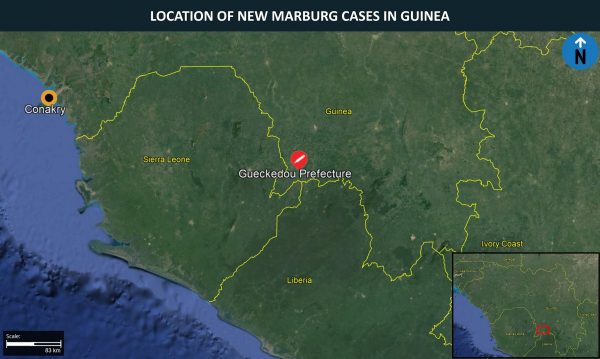10
Aug 2021
12:25 UTC
Guinea Alert: Government confirms first ever case of Marburg virus following death of patient in Gueckedou Prefecture, Nzerekore Region on August 9
Please be advised
- According to an official statement published by the World Health Organization (WHO), the Ministry of Health (MoH) confirmed a case of Marburg virus disease in the southern Gueckedou prefecture on August 9 after samples taken from a now-deceased individual tested positive for the virus.
- The statement notes that the individual had an initial onset of symptoms on 25 July and has visited a small health facility near Koundou on August 1 with symptoms of fever, headache, fatigue, abdominal pain, and gingival hemorrhage. However, the individual died after his condition rapidly deteriorated on August 2.
- On August 3, a real-time PCR was conducted which confirmed collected samples tested positive for Marburg and negative for Ebola virus. The result was then confirmed by laboratories in Conakry, and Senegal by August 9.
- Contract tracing operations are currently ongoing, with the patient thought to have been in contact with 155 people over the past two weeks. Three family members and a healthcare worker were identified as high-risk close contacts and their health is being monitored.
- The Marburg virus manifests as a highly infectious hemorrhagic fever similar to Ebola and starts when an infected animal, usually a monkey or fruit bat, passes the virus to humans. The virus then spreads from human to human by contact with an infected person’s body fluids.
- Symptoms include high fever, severe headache, and malaise, with case fatality rates have varied from 24 to 88 percent in past outbreaks. There are no vaccines or antiviral treatments approved to treat the virus.
Assessments & Forecast
- This development is highly notable as it is the first reported outbreak of the Marburg virus in West Africa, after previous outbreaks and sporadic cases have been reported in Angola, DRC, Kenya, South Africa, and Uganda. Additionally, Nzerekore Region is the same area, where a now concluded outbreak of Ebola was declared by the MoH on February 21, highlighting the possibility that the closely related viruses are endemic to the region. In this context, however, it is notable that a network of community health workers set up as part of this recent Ebola outbreak along with a WHO technical team remains in the area. That this team has now been repurposed to support the government’s response activities to this outbreak of Marburg is significant, given that the teams already have established protocols in place to deal with such a situation.
- Given the already existing response infrastructure, and the fact that Guinean authorities in coordination with the WHO managed to quell the Ebola outbreak in approximately four months, lends further confidence that the outbreak of the Marburg virus can be swiftly contained to a localized area. It is noteworthy that in attempting to conclude the Ebola outbreak the health workers faced challenges associated with locals’ resistance to response measures, which were perceived as contrary to the local cultural beliefs and practices. The team’s response to the Marburg virus outbreak is likely to encounter similar issues.
- FORECAST: However, response teams will likely be under pressure to swiftly contain any possible spread of the virus, given that Koundou is located near both the Sierra Leone and Liberia borders, with cross-border population movement and community mixing increasing the threat of a further spread of the outbreak. In this context, it is notable that points of entry across both borders are under reinforced surveillance, with two health control entry points being revitalized and briefed about the threat further highlighting regional authorities’ continued cognizance of the serious nature of the threat.
- FORECAST: The authorities’ containment efforts are also likely to be aided by the fact that Gueckedou Prefecture is relatively remote and sparsely populated. However, the remote location may hinder the mobilization of enough contact tracers and locating all relevant individuals who could have been connected to the patient. Ultimately, however, given the recent experience of tackling the Ebola outbreak, and the swift response of both local and international health authorities makes it likely that the outbreak can be contained fairly quickly.
Recommendations
- Those operating or residing in Guinea on August 10 and over the coming weeks are advised to avoid nonessential travel to Nzerekore Region due to the Marburg outbreak.
- Those remaining in Nzerekore are advised to practice stringent hygiene precautions and avoid all physical contact with those who have possible symptoms of an infection, which include high fever, severe headache and malaise. Continue to monitor your health for five to ten days after departing an area affected by Marburg virus due to its incubation period and contact medical professionals immediately if infection is suspected.
COUNTRY RISK LEVEL
Medium
AFFECTED AREA
Gueckedou Prefecture, Nzerekore Region
INCIDENT RISK LEVEL
High
STRENGTH OF SOURCE
Confirmed
Please be advised
- According to an official statement published by the World Health Organization (WHO), the Ministry of Health (MoH) confirmed a case of Marburg virus disease in the southern Gueckedou prefecture on August 9 after samples taken from a now-deceased individual tested positive for the virus.
- The statement notes that the individual had an initial onset of symptoms on 25 July and has visited a small health facility near Koundou on August 1 with symptoms of fever, headache, fatigue, abdominal pain, and gingival hemorrhage. However, the individual died after his condition rapidly deteriorated on August 2.
- On August 3, a real-time PCR was conducted which confirmed collected samples tested positive for Marburg and negative for Ebola virus. The result was then confirmed by laboratories in Conakry, and Senegal by August 9.
- Contract tracing operations are currently ongoing, with the patient thought to have been in contact with 155 people over the past two weeks. Three family members and a healthcare worker were identified as high-risk close contacts and their health is being monitored.
- The Marburg virus manifests as a highly infectious hemorrhagic fever similar to Ebola and starts when an infected animal, usually a monkey or fruit bat, passes the virus to humans. The virus then spreads from human to human by contact with an infected person’s body fluids.
- Symptoms include high fever, severe headache, and malaise, with case fatality rates have varied from 24 to 88 percent in past outbreaks. There are no vaccines or antiviral treatments approved to treat the virus.
Assessments & Forecast
- This development is highly notable as it is the first reported outbreak of the Marburg virus in West Africa, after previous outbreaks and sporadic cases have been reported in Angola, DRC, Kenya, South Africa, and Uganda. Additionally, Nzerekore Region is the same area, where a now concluded outbreak of Ebola was declared by the MoH on February 21, highlighting the possibility that the closely related viruses are endemic to the region. In this context, however, it is notable that a network of community health workers set up as part of this recent Ebola outbreak along with a WHO technical team remains in the area. That this team has now been repurposed to support the government’s response activities to this outbreak of Marburg is significant, given that the teams already have established protocols in place to deal with such a situation.
- Given the already existing response infrastructure, and the fact that Guinean authorities in coordination with the WHO managed to quell the Ebola outbreak in approximately four months, lends further confidence that the outbreak of the Marburg virus can be swiftly contained to a localized area. It is noteworthy that in attempting to conclude the Ebola outbreak the health workers faced challenges associated with locals’ resistance to response measures, which were perceived as contrary to the local cultural beliefs and practices. The team’s response to the Marburg virus outbreak is likely to encounter similar issues.
- FORECAST: However, response teams will likely be under pressure to swiftly contain any possible spread of the virus, given that Koundou is located near both the Sierra Leone and Liberia borders, with cross-border population movement and community mixing increasing the threat of a further spread of the outbreak. In this context, it is notable that points of entry across both borders are under reinforced surveillance, with two health control entry points being revitalized and briefed about the threat further highlighting regional authorities’ continued cognizance of the serious nature of the threat.
- FORECAST: The authorities’ containment efforts are also likely to be aided by the fact that Gueckedou Prefecture is relatively remote and sparsely populated. However, the remote location may hinder the mobilization of enough contact tracers and locating all relevant individuals who could have been connected to the patient. Ultimately, however, given the recent experience of tackling the Ebola outbreak, and the swift response of both local and international health authorities makes it likely that the outbreak can be contained fairly quickly.
Recommendations
- Those operating or residing in Guinea on August 10 and over the coming weeks are advised to avoid nonessential travel to Nzerekore Region due to the Marburg outbreak.
- Those remaining in Nzerekore are advised to practice stringent hygiene precautions and avoid all physical contact with those who have possible symptoms of an infection, which include high fever, severe headache and malaise. Continue to monitor your health for five to ten days after departing an area affected by Marburg virus due to its incubation period and contact medical professionals immediately if infection is suspected.


